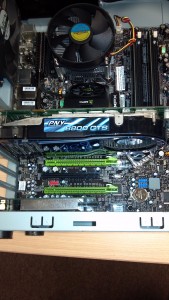 What temperature does your CPU run at? Do you know what the normal operating temperature of your processor is? Most people don’t. How do you know your machine is overheating? Most times these issues are difficult to troubleshoot because there is no error. If your PC’s BIOS has a hardware monitor you can check it there,and laptops generally get extremely hot to the touch around the exhaust & CPU area. If your machine doesn’t have any way of monitoring the temperature, it can be even more of a challenge to locate the heating problem.
What temperature does your CPU run at? Do you know what the normal operating temperature of your processor is? Most people don’t. How do you know your machine is overheating? Most times these issues are difficult to troubleshoot because there is no error. If your PC’s BIOS has a hardware monitor you can check it there,and laptops generally get extremely hot to the touch around the exhaust & CPU area. If your machine doesn’t have any way of monitoring the temperature, it can be even more of a challenge to locate the heating problem.
While heating issues are more common in custom built machines, they also can occur in pre-built units (Dell, HP, Acer etc) and often happen with older laptops. The most common issue with custom built machines is thermal paste not being applied correctly, same with laptops, although laptops can also accumulate a lot of dust in the fan/exhaust area causing it to heat up and reboot or turn off.
Here is a list of things to check if you notice your machine is overheating.
- Check the thermal paste application.
Thermal paste, especially cheap stuff turns chalky over time, if you are experience overheating, this would be the first thing to check. Find yourself some nice silver compound (we recommend arctic silver www.arcticsilver.com) and apply a THIN coat on your processor and reseat the heatsink. - Is your fan pushing enough air and supplying enough cooling to your processor?
Most stock fans today do not supply enough cooling to the processor causing it to overheat – aftermarket fans can be purchased to remedy the issue and often are inexpensive (15$-50$ for a decent after market upgrade) - Dust & Air Restriction
This can be a major factor with your PC or laptop. Check for those nasty thick clumps of dust around exhaust ports or the heatsink itself. You might be blocking a way for the heat to escape causing the machine to cook itself. Find yourself either a can of c02 to blow the dust out, or we often use a wet/dry vac with an exhaust port that blows the dust out. - Room Temperature
Obviously if youre browsing the web inside of a boiler room, youre not going to be browsing for long. If the temperature of your room is over 85 or 90 degrees, you might want to think about relocating your computer. The machine won’t be able to cool itself if the air around it is hotter than itself.
Temporary Fixes for an Overheating PC
- Take the side of the case off – this allows the machine to breath better and effectively reduces the overall temperature of the unit.
- Get a fan or air conditioner and have it blow in the side of the case (with the side of the case off)
- Purchase additional case fans – Some PC’s come with none of these, the air just sits inside the case without any actual flow – a case fan will move the air around – this will increase air flow inside the unit – reducing the overall temperature of this unit.
We get on average, 5 people a week who drop off their laptop or desktop in our shop because of overheating issues. Following these tips in most cases will fix your overheating computer, but if you are still in need of help or unsure what to do – give us a call at 860-942-8522. Logistics has experience resolving the most complicated overheating issues with laptops and desktops. We even accept mail in orders.
Thanks for reading, if this article helped you in anyway, leave a comment – we love feedback.
